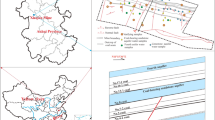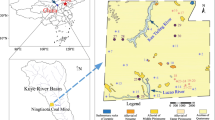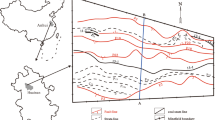Abstract
The mine water source discrimination plays an important role in guiding mine water prevention in the water prevention work. Improving especially the discrimination accuracy of mine water sources which will cause water inrush is the important foundation of avoiding such accident and thus ensuring personnel and property being in safety. Based on Fisher discriminant analysis theory (FDA) and gray correlation analysis theory (GCA), groundwater chemical components (Ca2+, Mg2+, K++Na+, Cl−, SO4 2−, and HCO3 −) data at main water inrush aquifers in a typical coal mine through experiments, FDA-GCA recognition model of water inrush sources was established and then verified. Results indicated that the FDA-GCA recognition model of water inrush sources was characterized by high discrimination precision, and false determination rate obtained by back-substitution estimation method was zero. Thus, it had strong discrimination ability of water inrush sources. The significance ranking of input variables in the water source FDA-GCA recognition model was Ca2+ > Mg2+ > HCO3 − > SO4 2− > K+ + Na+ > Cl−. The data in this paper were discriminated by the distance discriminant method and BP neural network discriminant analysis method, the correct rate of which is 90%, 80%, slightly lower than or equal to the accuracy of 90% by the FDA-GCA recognition model.


Similar content being viewed by others
References
Cao B, Bai G, Li H (2015) Prediction of gas content based on PCA-GA-BP neural network. J Saf Sci Technol 11(5):84–90
Chen HJ, Li XB, Liu AH et al (2009) Identifying of mine water inrush sources by Fisher discriminant analysis method. J Cent South Univ 40(4):1114–1120
Chen JH, Zheng RK, Chen H (2014) Analysis on slope stability based on combination of CA and BP neural network. China Saf Sci J 10(5):142–147
Guo Q (2013) Study on water inrush of limestone aquifer in Lvliang coal mine. J Saf Sci Technol 9(6):16–20
Hu JX, Zhang GJ (2013) K-fold cross-validation based selected ensemble classification algorithm. Bull Sci Technol 29(12):115–117
Huang PH, Chen JS (2011) Fisher identify and mixing model based on multivariate statistical analysis of mine water inrush sources. J China Coal Soc 36:131–136
Huang P, Han S (2016) Assessment by multivariate analysis of groundwater–surface water interactions in the Coal-mining Exploring District, China[J]. Earth Sci Res J 20(1):G1–G8
Jing CL, Jiang HQ (2012) Prediction of karst collapse based on Fisher discriminant analysis method. J Earth Sci Environ 34(1):91–95
Kanti KM, Rao PS (2008) Prediction of bead geometry in pulsed GMA welding using back propagation neural network. J Mater Process Technol 200:300–305
Keskin TE, Düğenci M, Kaçaroğlu F (2015) Prediction of water pollution sources using artificial neural networks in the study areas of Sivas, Karabük and Bartın (Turkey). Environ Earth Sci 73:5333–5347
Li Y, Sun YJ, Xu ZM et al (2010a) Analysis of composition of mine inflow from complicated Multi Aquifer affecting safety production in coal mines. J Min Saf Eng 279(3):433–437
Li Y, Xu ZM, Liu Y (2010b) Summary on methods of distinguishing sources of mine water-invasion. Coal Technol 29(11):87–89
Liang YT, Yang ZH, Qu LW (2013) Mine roof fall prediction technique based on multi-source information fusion. J Xi’ an Univ Sci Technol 33(1):78–83
Lu JT, Li XB, Gong FQ et al (2012) Recognizing of mine water inrush sources based on principal components analysis and Fisher discrimination analysis method. Chinese Saf Sci J 79:109–115
Nie FQ, Xu GQ, Gan WJ et al (2013) Application of Ma Distance discriminant model on water source identification of mine water inrush. Ground Water 35(6):41–42
Qian JZ, Lv C, Zhao WD et al (2010) Application of Elman and BP neural networks in discriminating water bursting source of coalmine. Syst Eng Theory Pract 30(1):145–150
Richard A, Johnson DWW (2002) Applied multivariate statistical analysis[M]. [s.1]:Prentice Hall
Wang XY, Xu T, Huang D (2011) Application of distance discriminance in identifying water inrush resource in similar coalmine. J China coal soc 36(8):1354–1358
Wang JY, Li ZY, Zhang XQ et al (2013) Discrimination of water bursting source in mine based on radial basis function neural network optimized by particle swarm optimization. Saf Environ Eng 20(5):118–121
Wen TX, Zhang B, Shao LS (2014) QGA—LSSVM model for mine water inrush source identification. J Saf Sci Technol 24(7):111–116
Wu JW, Xu SP, Zhai XR et al (2015) Hydrochemical characteristics and water sources discrimination of coal bearing sandstone water in the north eighth mining area of Taoyuan coal mine in Huaibei. J Saf Sci Technol 11(1):84–90
Xu ZJ, Yang YG, Tang L (2007) Application of BP neural network in evaluation of water source in mine. Saf Coal Mines 38(2):4–6
Xu X, Guo BB, Wang GZ (2016) Application of artificial neural network in recognition mine multiple water sources. J Saf Sci Technol 12(1):181–185
Yan ZG, Bai HB (2009) MMH support vector machines model for recognizing Multi-Headstream of water inrush in mine. Chin J Rock Mech Eng 28(2):324–329
Yang YG, Huang FC (2007) Water source determination of mine inflow based on nonlinear method. J China Univ Min Technol 36(3):283–286
Yang HJ, Wang GC (2012) Summarization of methods of distinguishing sources and forecasting inflow of water inrush in coal mines. Coal Geol Explor 40(3):48–54
Yang FQ, Liu GN, Guo LL (2015) Improved SVM and GA-BP neural network model of mine water inrush sources identification. Nonferrous Mets (Mining Section) 67(1):87–91
Zhang XL, Zhang ZX, Peng SP (2003) Application of the second theory of quantification in identifying gushing water sources of coal mines. J China Univ Min Technol 32(3):251–254
Zhang SJ, Zhu RJ, Jiang CL et al (2013) Prediction model for gas emission quantity in mining face based on partial leastsquares regression. Saf Coal Mines 44(2):7–11
Zhao LN (2013) Research and application of Fisher discriminant method[D].Harbin:Northeast Forestry University
Zhu C, Qian JZ, Zhou XP et al (2010) Water inrush source discrimination with BP neural network in Pansan Mine. J Anhui Inst Archit Ind (Nature Science Edition) 18(5):35–38
Acknowledgements
This work was financially supported by China Postdoctoral foundation project (Grant Nos. 2017M612395) and the Technological Innovation Team of Colleges and Universities in Henan Province (Grant No. 15IRTSTHN027).
Author information
Authors and Affiliations
Corresponding author
Rights and permissions
About this article
Cite this article
Ping-hua, H., Xin-yi, W. & Su-min, H. Recognition model of groundwater inrush source of coal mine: a case study on Jiaozuo coal mine in China. Arab J Geosci 10, 323 (2017). https://doi.org/10.1007/s12517-017-3099-5
Received:
Accepted:
Published:
DOI: https://doi.org/10.1007/s12517-017-3099-5




